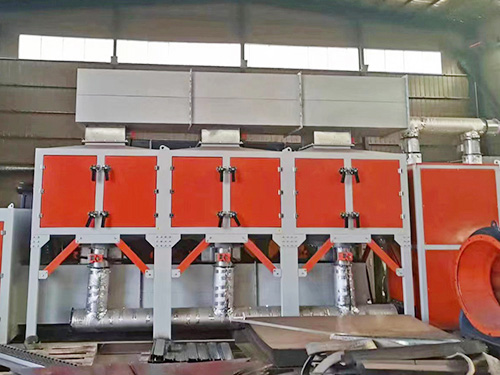VOC Catalytic Combustion EquipmentIn The Catalytic Purification Process, The Role Of The Catalyst Is To Reduce The Activation Energy, And At The Same Time, The Catalyst Surface Has Adsorption Effect, Allowing Reactant Molecules To Accumulate On The Surface, Increasing The Reaction Rate And Accelerating The Reaction; With The Help Of Catalysts, The Temperature Of Exhaust Gas Can Be Reduced (based On Actual Reports). Under The Ignition Temperature Conditions, Flameless Combustion Occurs, Oxidizing And Decomposing Into CO2 And H2O, While Releasing A Large Amount Of Heat Energy, Thus Achieving The Method Of Removing Useless Substances From Exhaust Gas.
This Acoustic Catalytic Combustion Equipment Is Suitable For Processing Small Volume, High Concentration (based On Actual Reports) Exhaust Gases. It Is Usually Used In Conjunction With The Adsorption Process Of Activated Carbon. The Activated Carbon Carbon Attachment Device Concentrates High-capacity, Low Concentration (based On Actual Reports) Exhaust Gas Into Small Capacity, And High Concentration (based On Actual Reports) Exhaust Gas
The Exhaust Gas Meets The Usage Conditions Of Catalytic Purification Equipment.
Working Principle:
VOC Catalytic Combustion Equipment Is An Exothermic Reaction, And The Amount Of Heat Released Depends On (based On Actual Reports) The Type And Content Of The Substance.
If The Reaction Heat Generated By Exhaust Gas Combustion Can Be Relied Upon To Maintain The Catalytic Combustion Process, It Is Still An Economical Operating Method.
Whether The Normal Reaction Of The Self Heating Maintenance System Can Be Achieved Depends On The Conditions, Such As The Heat Release During Combustion, The Ignition Temperature Of The Catalyst, The Heat Recovery Rate, And The Initial Exhaust Gas Temperature. The Ignition Temperatures Corresponding To The Catalyst Are 200 ° C, 250 ° C, And 300 ° C, Respectively; The Initial Temperatures Of The Exhaust Gas Are 30 ° C And 150 ° C, Respectively. The Higher The Initial Temperature Of The Exhaust Gas, The Higher The Concentration Of Substances In The Exhaust Gas (based On Actual Reports), And The Greater The Possibility Of Achieving Self Heating Operation.
It Is Common To See Residues Of Approximately 5000mg/m3 (based On Actual Reports) In Industrial Waste Gas (based On Actual Reports). As Long As The Heat Exchange Efficiency Of The Heat Exchanger Can Reach 50% -60%, It Can Be Used To Recover The Heat Of Combustion Reaction To Maintain Continuous Catalytic Combustion.
The Pollutants In The Foul Odor Of Catalytic Combustion Equipment Have Been Completely Decomposed. Advantages: Small Footprint, Low Investment, And Low Operating Costs; Easy To Manage And Available At Any Time. Disadvantages: Good Performance Load, Not Easily Affected By Changes In Pollutant Concentration And Temperature, Therefore Requiring A Determined Consumption. With The Continuous Development Of Society And The Diagnosis And Treatment Industry, As Well As The Continuous Development Of Chemical Enterprises, The Pollution Problems Caused By The Chemical Industry Are Becoming Increasingly Serious. In The Research And Production Process Of The Chemical Industry, It Is Easy To Generate (based On Actual Reports) (based On Actual Reports) Waste Gas. Due To The Complex Chemical Composition Of Exhaust Gas, The Problem Of Exhaust Gas Pollution Caused By The Chemical Industry. If Not Strictly Controlled And Handled, A Large Amount Of Stable Gas Will Threaten The Lives Of People Around It.
Therefore, Feasible Strategies Should Be Developed To Address Its Issues And Reduce The Losses Caused By Chemical Pollution.
After The Control And Treatment Of Chemical Waste Gas By Relevant Departments, There Have Been Significant Practical Effects, But Not Very Good Practical Effects. There Are Still Significant (based On Actual Reports) Waste Gas Treatment Issues In The Chemical Industry.
Some Chemical Waste Gas Companies Have Seriously Polluted The Air.
The Working Process Of The Electrical Control System Of VOC Catalytic Combustion Equipment Is Divided Into Three States: The Working State Of The Burner, The Stopping State, And The Parameter Setting State.
In Working Condition, It Is Divided Into Ignition Process And Combustion Process.
The Temperature Has Been Detected By The Installed Thermocouple And Sent To The Text Display For Display.




